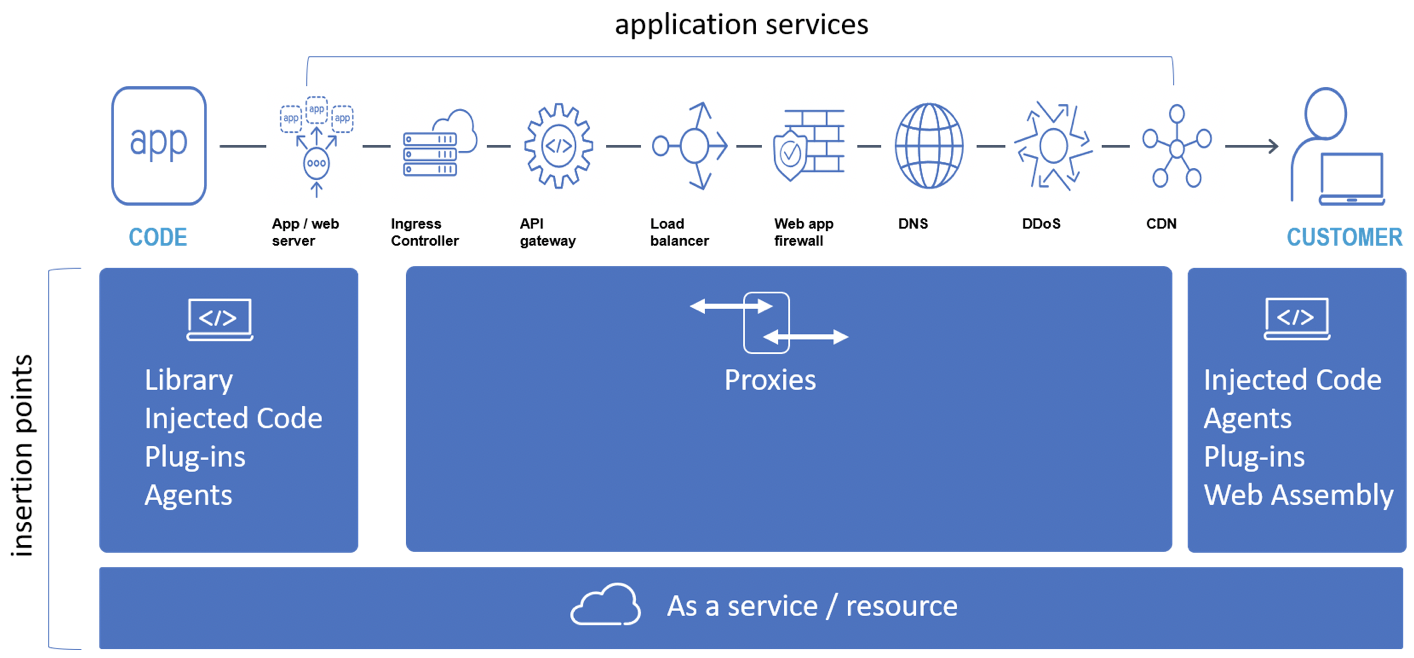変化するアプリ アーキテクチャにアプリ サービスを挿入する
applicationアーキテクチャは、コンピューティングの初期の頃から何度も進化してきました。 長く存続している企業の中には、5 つ目の個別のapplicationアーキテクチャを導入しているところもあります。 現在、多くの人がそれぞれのapplicationsを運用および保守しています。 つまり、近々発表される2020 年のapplicationサービスの現状に関する調査結果によると、ほとんどの組織が次のような現実に直面しています。

各アプリ アーキテクチャは、ネットワーク アーキテクチャ、テクノロジ、セキュリティ、application(配信) サービスなど、上流のすべてに大きな影響を与えます。 最新のアーキテクチャの変化であるマイクロサービスの中心にあるのは、「アトマイゼーション」または「コンポーネント化」と呼ばれる概念です。 どちらも本質的には、市場投入までの時間、コードの品質、俊敏性を向上させる目的で、applicationをより小さく管理しやすいコンポーネントに分割するプロセスを指します。
以前の世代のアプリ アーキテクチャでは、特定の種類のapplicationサービスを挿入する最も効率的なポイントはネットワークのままでした。 最近まで、プロキシは、アプリからクライアントに伸びるデータ パスにこれらのサービスを挿入する主な手段でした。
しかし、そのデータ パスは、最新のapplicationアーキテクチャとともに分解されつつあります。 現在では、インターネット、クラウド プロパティ、データ センターにまで広がっています。 application機能の重要なコンポーネントとしてクライアントがますます含まれるようになっています。
したがって、applicationサービスを挿入するために単一の既知のデータ パスのみに依存することは、もはや最適ではありません。 さらに、新しいデータ パスの多くはプロキシ ベースのプラットフォームには適していないため、最新のapplicationsを拡張および保護するために、他の挿入ポイントの可能性を検討する必要があります。
applicationサービス挿入ポイント
applicationサービスをデータ パスに「挿入する」という概念により、applicationサービスの展開に関するこの最新の考え方、つまり挿入ポイントを簡単に説明できます。

このモデルでは、従来の挿入ポイント (プロキシ) と、アプリ/Web サーバーやクライアント デバイスなどの他の場所を区別します。 各場所には、applicationサービスの挿入に適した複数のフォームがあります。
プロキシ
ネットワークの従来のネットワーク挿入ポイントには、プロキシベースのapplicationサービスと、その最新の同等物である、一部のサービス メッシュ ソリューションの基盤を形成するサイドカー プロキシがあります。 どちらも「ネットワーク内」に展開されるため、フォーム ファクター (コンテナー、ソフトウェア、ハードウェア) に関係なく、その場所にアクセスする必要があります。
プロキシは、applicationサービスを挿入するための効率的な手段であり続けます。 今日のプロキシに対する最新のアプリ アーキテクチャの最大の影響は、その焦点にあります。 従来、プロキシは多くのapplicationsのapplicationサービスをホストしていましたが、今日のアーキテクチャでは、よりアプリごとのアプローチが求められています。 したがって、プロキシはapplicationsとそのインフラストラクチャに組み込まれ、以前のプロキシ ソリューションよりもはるかに細かい焦点を持つ傾向があります。
プロキシレス
すべてのapplicationsと環境がそのアクセスを提供するわけではないため (SaaS を考えてください)、applicationサービスを展開できる代替挿入ポイントを検討します。 これらの代替ポイントは、展開と実行にプロキシを必要としない、またはプロキシに依存しないため、大まかに「プロキシレス」と呼ばれています。 これらのサービスは、従来のエージェント(サーバーまたはapplicationの一部として展開されるソフトウェア)の形式をとる場合もあれば、開発者にとってより使いやすいコードベースのオプションの形式をとる場合もあります。 JavaScript ライブラリや Web サーバー、ブラウザー プラグインなどの挿入されたコードは、これらの代替場所の挿入ポイントの良い例です。
サービス
applicationサービスの多くは、「サービスとして」提供される場合があります。つまり、クラウド ベースのサービスとしてホストされます。 挿入には、依然としてそれらのサービスを呼び出すためのアクセスが必要です。そのため、コードまたは構成アーティファクトによる何らかの形式の挿入なしに、そのようなサービスがapplicationに含まれることはほとんどありません。
最新のapplicationアーキテクチャによって形成されたこの新しい状況を考えると、applicationサービスが適合する場所に対する答えは、ますます、アプリ (またはアプリの一部) が存在する可能性のあるあらゆる場所になります。 アプリ アーキテクチャが分解されると、applicationコンポーネントの配信を拡張、保護、高速化するために使用されるアプリ サービスも分解されます。
挿入ポイントの拡張は、テレメトリとよりスマートな自動化に対する将来のニーズをサポートするために必要な進化のステップの 1 つにすぎません。 組織がデジタル トランスフォーメーションの道を歩み続けるにつれて、アプリ サービスも拡大し、進化し続けるでしょう。
